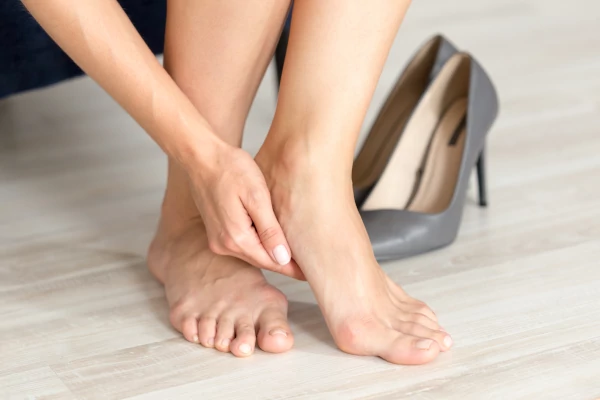Are you tired of suffering from heel pain and want to find a solution that actually works? Look no further than Heel Pain No More, the ultimate guide to beating plantar fasciitis.
Plantar fasciitis is a common condition that affects many people worldwide. It is a painful and frustrating condition that can significantly impact your quality of life, making even the simplest of activities, such as walking, unbearable. Fortunately, with the right information, you can alleviate the pain and start living your life to the fullest again.

In this guide, we will provide you with everything you need to know about plantar fasciitis and how to overcome it. We will discuss the causes of the condition, the symptoms, and the most effective treatment options available. By the end of this guide, you will have all the information you need to beat heel pain once and for all.
What is Plantar Fasciitis?
Plantar fasciitis is a condition that affects the plantar fascia, a thick band of tissue that runs across the bottom of your foot, connecting your heel bone to your toes. The plantar fascia provides support to your foot arch and helps you walk. When this tissue becomes inflamed or irritated, it can cause a sharp pain in the heel or arch of the foot.
Causes of Plantar Fasciitis
The causes of plantar fasciitis vary, but most cases occur from overuse and stress on the feet. This can happen from activities that involve a lot of running, jumping, or standing for long periods, such as sports or working on hard surfaces. Other factors that may contribute to plantar fasciitis include:
- Flat feet or high arches
- Tight calf muscles
- Being overweight or obese
- Wearing shoes with inadequate support or cushioning
Symptoms of Plantar Fasciitis
The most common symptom of plantar fasciitis is a pain in the heel or arch of the foot, especially when taking the first few steps in the morning or after sitting for an extended period. The pain may subside as the day goes on, only to return after a prolonged period of standing or physical activity.
Treatment Options for Plantar Fasciitis
Fortunately, there are various treatment options available for plantar fasciitis. The most effective treatment options include:
Medications
Over-the-counter pain relievers, such as ibuprofen or acetaminophen, can help reduce pain and inflammation. In severe cases, your doctor may prescribe corticosteroids to reduce inflammation.
Physiotherapy
- Rest and Ice
One of the most common treatments for plantar fasciitis is rest and ice. It is crucial to give your feet time to heal and recover. Apply ice to the affected area for 15-20 minutes every few hours to reduce inflammation and pain. - Stretching and Exercises
Stretching and exercises can help alleviate plantar fasciitis by increasing flexibility. Some of the most effective exercises include calf stretches. - Strengthening exercises
Strengthening exercises can help alleviate plantar fasciitis by increasing the strength of the muscles. Some of the most effective exercises include toe raises. - Footwear and Orthotics
Wearing shoes with adequate support and cushioning can help reduce stress on the plantar fascia. Orthotics, such as arch supports or custom-made insoles, can also help provide additional support and cushioning. - Taping of the foot
K-taping for plantar fasciitis involves applying tape in a specific pattern to support and reduce pain in the affected area. - Dry needling
Dry needling for plantar fasciitis is a minimally invasive technique that involves inserting fine needles into trigger points in the foot to release tension and promote healing. - Extracorporeal Shock Wave Therapy (ESWT)
ESWT is a non-invasive treatment that uses shock waves to stimulate healing in the affected area. It is a highly effective treatment option for plantar fasciitis that has not responded to other treatments.
FAQs
Can plantar fasciitis go away on its own?
In some cases, plantar fasciitis may go away on its own with rest and conservative treatments. However, for many people, professional treatment is necessary to manage symptoms and prevent further injury.
What exercises can I do to relieve plantar fasciitis pain?
Stretching exercises such as calf stretches and towel stretches can help relieve plantar fasciitis pain. Strengthening exercises, such as toe curls and heel raises, can also help.
Are there any natural remedies for plantar fasciitis?
There are several natural remedies that may help relieve plantar fasciitis pain, such as icing the affected area, massaging the foot, and taking over-the-counter pain relievers.
Can I still exercise with plantar fasciitis?
Yes, you can still exercise with plantar fasciitis, but it’s important to avoid high-impact activities such as running and jumping. Low-impact exercises such as cycling and swimming may be a better option.
How long does it take to recover from plantar fasciitis?
The recovery time for plantar fasciitis varies depending on the severity of the condition and the type of treatment used. In many cases, it can take several weeks or even months to fully recover.
In conclusion, plantar fasciitis can be a painful and frustrating condition, but it is manageable with the right treatments and preventative measures. By following the advice in this ultimate guide, you can reduce your risk of developing plantar fasciitis, manage your symptoms, and return to your active lifestyle. Remember to wear proper footwear, stretch before exercise, and seek professional treatment if necessary. With these steps, you can say goodbye to heel pain and enjoy a healthy, active life.


